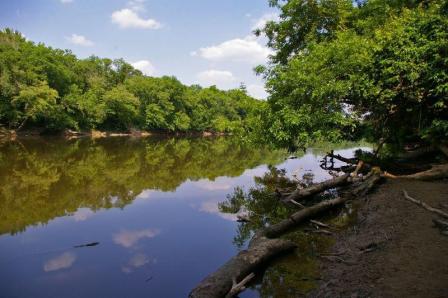Supporting States, Tribes, and Communities on PFAS
Published June 18, 2018
In order to protect public health and the environment, EPA works collaboratively with states, tribes, and local governments. Around the country, EPA researchers respond to requests for assistance from states, tribes, and local communities through EPA regions and program offices and EPA Technical Support Centers.
 The Cape Fear River in North Carolina EPA scientists and engineers offer their expertise and provide services such as site characterization, modeling, monitoring, assessment, and remediation. Over the last few years, requests for assistance regarding per- and poly-fluoralkyl substances (PFAS) have increased. PFAS chemicals are a group of man-made chemicals manufactured and used in a variety of industries globally since the 1940’s. These chemicals have many properties, such as the ability to make commercial and consumer products non-stick or water-repellent, and are extremely stable. However, those same characteristics that make these chemicals attractive to industry also have implications to human health and the environment.
The Cape Fear River in North Carolina EPA scientists and engineers offer their expertise and provide services such as site characterization, modeling, monitoring, assessment, and remediation. Over the last few years, requests for assistance regarding per- and poly-fluoralkyl substances (PFAS) have increased. PFAS chemicals are a group of man-made chemicals manufactured and used in a variety of industries globally since the 1940’s. These chemicals have many properties, such as the ability to make commercial and consumer products non-stick or water-repellent, and are extremely stable. However, those same characteristics that make these chemicals attractive to industry also have implications to human health and the environment.
Through EPA’s Technical Support Centers, states, tribes, and local governments request help from EPA in identifying, monitoring, cleaning up, and reducing PFAS occurrence in drinking water, soils, air, and ground water at sites around the country. This allow EPA researchers to share and implement the latest scientific knowledge from their research conducted in the laboratory and at pilot scale. It also benefits EPA researchers by bringing forward real-world conditions and issues that states, tribes, and local communities face on a continual basis. This informational exchange among researchers and decision-makers greatly improves EPA’s research program because researchers can help solve real-time environmental problems that communities face. Some of these efforts include:
- Conducting targeted (when you know what chemical you are looking for) and non-targeted (when you are looking to see what might be there) analyses of PFAS chemicals in water and drinking water at the Cape Fear River in North Carolina and in air and soils at a manufacturing site in New Hampshire.
- Collaborating with water utilities to test drinking water treatment technologies in several states and determine which technologies will work best to remove PFAS chemicals from drinking water.
- Sampling, analyzing, and interpreting data to determine what PFAS chemicals are present at a fuel storage site in Rhode Island.
These efforts inform decision makers at the state, tribal, and local levels. They also provide an opportunity for researchers to refine methods and analysis, increase the knowledge base about the chemicals, their occurrence, and potential health effects, and improve technologies to treat drinking water, clean up chemicals in the environment, and reduce human exposure.
For more information about PFAS, please visit www.epa.gov/pfas
